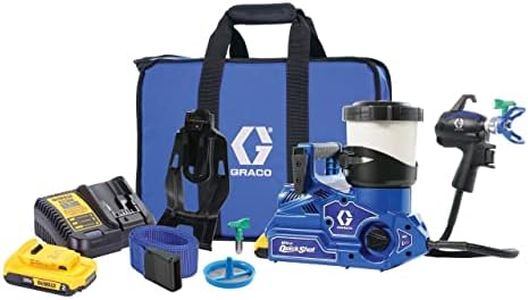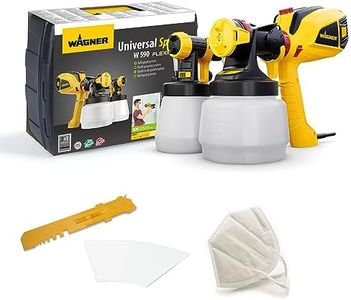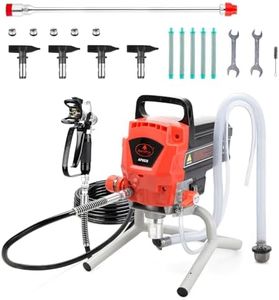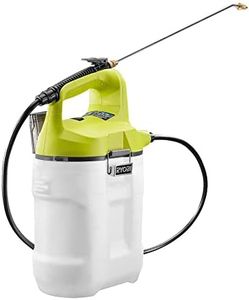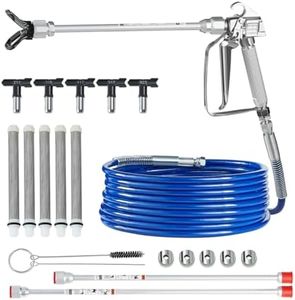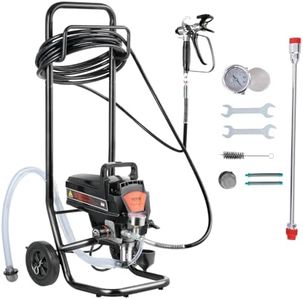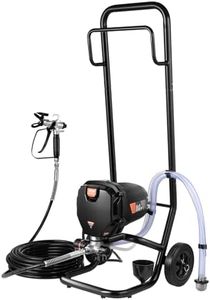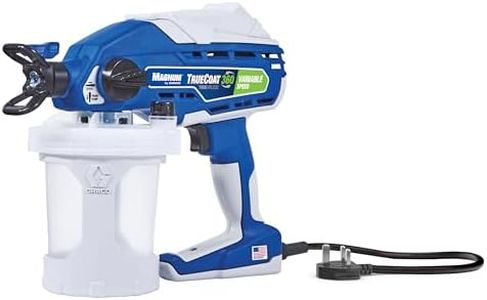We Use CookiesWe use cookies to enhance the security, performance,
functionality and for analytical and promotional activities. By continuing to browse this site you
are agreeing to our privacy policy
10 Best Airless Paint Sprayers
From leading brands and best sellers available on the web.By clicking on a link to a third party's website, log data is shared with that third party.
Buying Guide for the Best Airless Paint Sprayers
Choosing an airless paint sprayer can make painting large areas faster and give a more even finish compared to brushes or rollers. The key to selecting the right one is to match the sprayer’s capabilities to the projects you plan to tackle. Consider how often you'll use it, what surfaces you’ll be painting (walls, fences, furniture, etc.), and the types of paint or coatings you'll use. Learning a bit about the main features helps you avoid frustration and ensures smoother projects.Motor Power (Horsepower or Watts)Motor power in an airless paint sprayer indicates how strong the unit is. Higher power means the sprayer can handle heavier and thicker paints and push the paint through longer hoses or at higher pressures. For smaller, occasional projects, a lower-powered sprayer might be fine and easier to handle, while if you plan to paint large or multiple surfaces or use thicker paints, a higher-powered unit ensures efficient and consistent spray.
Maximum Pressure (PSI)Pressure, measured in PSI (pounds per square inch), shows how forcefully the sprayer expels paint. High pressure lets you cover surfaces more quickly and manage thicker paints or longer hoses, but too much pressure can waste paint or cause overspray. Lower pressure is gentler and suitable for more detailed, smaller projects or thin paints. Match the pressure to your paint type and project size—higher for big, exterior jobs and lower for furniture or smaller tasks.
Flow Rate (Gallons per Minute or Liters per Minute)Flow rate tells you how much paint the sprayer can apply in a minute. A higher flow rate covers more area quickly, great for big walls, fences, or decks, but might be overkill for smaller projects or detailed work. A lower flow rate allows more control and precision but takes longer for larger projects. Think about whether you value speed or fine detail when choosing this feature.
Tip Size CompatibilityThe tip or nozzle size determines the spray pattern’s width and how much paint comes out. Different tips are better for different coating types (like thin stains versus thick latex paint). Some sprayers can only accept smaller tips, good for thinner paints and small jobs, while more versatile models can use a range of tips for all project types. Make sure the sprayer you pick supports the tips required for the paints and finishes you plan to use.
Hose LengthHose length affects how far you can work from the paint source. Long hoses make it easy to reach ceilings or move around big areas without relocating the main unit, but can reduce pressure if the sprayer isn’t very powerful. Short hoses are lighter and easier to manage for confined spaces or quick jobs. Consider the spaces you’ll be painting—large outdoor areas favor long hoses, while small rooms are fine with shorter ones.
Portability and WeightPortability refers to how easily you can move or carry the sprayer, which is important if you’ll be working in different locations or need to store it away often. Lighter units are easier for one person to carry but might have more limited features, while heavier sprayers can handle more demanding jobs but may come with wheels for easier transport. Your choice should reflect how often you’ll need to move the sprayer and how big your projects are.
Cleaning and Maintenance FeaturesCleaning is essential after each use to keep your sprayer working well. Look for features that simplify cleaning, like quick flush systems or easy-access filters. Sprayers that are hard to clean can waste time and paint and may clog up if not well maintained. If you value convenience and time, prioritize models designed for easy cleaning and maintenance.

